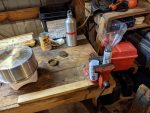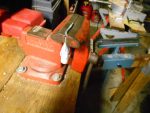The squeeze tube was invented by artist John Goffe Rand in 1841. It was originally designed to contain and dispense paint. By 1889, Johnson and Johnson began selling toothpaste in tubes. When I lived in Norway during the 1990s, I enjoyed dispensing cod caviar onto crackers from squeeze tubes. Squeeze tubes provide a convenient container/dispenser for substances that might otherwise be messy to use.
One day recently as I was brushing my teeth, I was thinking that many toothpaste tubes are now plastic, whereas formerly they were usually made of metal. As I thought about this, I began to wonder if an empty plastic squeeze tube could be cut open, cleaned out, refilled, resealed, and reused. I decided to give it a try.
The First Test
 My first granddaughter was recently born in another state. My wife and I went to visit my daughter and her family in order to welcome and celebrate the new arrival. While we were there, I used up a travel-sized tube of Colgate toothpaste. I decided that this small tube would work well for my first experiment. With a small tube, a smaller quantity of the contents would be wasted if the experiment failed. So I saved the empty tube rather than throwing it away.
My first granddaughter was recently born in another state. My wife and I went to visit my daughter and her family in order to welcome and celebrate the new arrival. While we were there, I used up a travel-sized tube of Colgate toothpaste. I decided that this small tube would work well for my first experiment. With a small tube, a smaller quantity of the contents would be wasted if the experiment failed. So I saved the empty tube rather than throwing it away.
 After I returned home, I removed the cap from the tube, and cut off the bottom with a pair of scissors. I then opened up the tube and rinsed it thoroughly in warm water until the residual traces of toothpaste were washed away. I thoroughly rinsed the cap as well, and then left the tube and cap on a towel on the bathroom counter to dry. This process left the room smelling “minty fresh.” I decided that petroleum jelly would be the best material to transfer to the tube in this first experiment. My favorite tinder, with the possible exception of birch bark, is a cotton ball dabbed with petroleum jelly. A squeeze tube is a very convenient container for carrying and dispensing that material. On February 4, 2021, SurvivalBlog published an article in which I described preparing a reusable squeeze tube to dispense petroleum jelly. Now I would be seeing if I could re-purpose a disposable tube for the same task.
After I returned home, I removed the cap from the tube, and cut off the bottom with a pair of scissors. I then opened up the tube and rinsed it thoroughly in warm water until the residual traces of toothpaste were washed away. I thoroughly rinsed the cap as well, and then left the tube and cap on a towel on the bathroom counter to dry. This process left the room smelling “minty fresh.” I decided that petroleum jelly would be the best material to transfer to the tube in this first experiment. My favorite tinder, with the possible exception of birch bark, is a cotton ball dabbed with petroleum jelly. A squeeze tube is a very convenient container for carrying and dispensing that material. On February 4, 2021, SurvivalBlog published an article in which I described preparing a reusable squeeze tube to dispense petroleum jelly. Now I would be seeing if I could re-purpose a disposable tube for the same task.
With that in mind, I took the dried tube and cap to the barn. There I lighted my Norwegian “Storm Kitchen” alcohol stove and put a pot of snow on the stove to melt. Then I put the cap on the tube, and secured the cap in the vise on my workbench with the open bottom of the tube uppermost.
Next, I looked in the recycling bin for something that I could make into a funnel. I could not find anything small enough to fit the opening in the bottom of the tiny tube. Finally, I found a plastic cup with a pour spout, and decided that it would have to do the job.
When the snow was sufficiently melted, I put a jar of petroleum jelly in the pan on top of a metal coil. The coil was to prevent the jar from making direct contact with the bottom of the pan, and being in that way possibly overheated.
While I was waiting for the water to boil, I sorted through some old camping equipment. The mice had ruined a number of cloth items like mess kit covers, so I threw them away. Banana boxes do not protect their contents from rodents.
 After about 45 minutes, the water began to boil, and the petroleum jelly began to melt. I poured some into the spouted cup, and then poured from the cup into the tube until it was about half full. I then extinguished the stove, and allowed the petroleum jelly in the tube to cool. After the jelly had cooled, I clamped the tube into the vise with the bottom 1/8 inch of the tube exposed above the vise. I then lit a propane torch, and heated the portion of the tube that was above the vise while using the vise as a heat sink to protect the rest of the tube. The portion above the vise melted together, forming an effective seal.
After about 45 minutes, the water began to boil, and the petroleum jelly began to melt. I poured some into the spouted cup, and then poured from the cup into the tube until it was about half full. I then extinguished the stove, and allowed the petroleum jelly in the tube to cool. After the jelly had cooled, I clamped the tube into the vise with the bottom 1/8 inch of the tube exposed above the vise. I then lit a propane torch, and heated the portion of the tube that was above the vise while using the vise as a heat sink to protect the rest of the tube. The portion above the vise melted together, forming an effective seal.
Each day for the next several days, I squeezed a dab of petroleum jelly about the size of a pea onto a cotton ball. I consider this to be the ideal amount of petroleum jelly for starting a fire. The tube held up fine to this use. I was fully satisfied with the results of the first test.
The Second Test
During the course of the following weeks, my household used up a large tube of Crest toothpaste and a tube of Eucerin hand lotion. I put both empty tubes aside for future use.
I also ran across a tin of petroleum jelly that I had purchased in Norway. The tin was quite similar to the kind in which shoe polish is often sold. It reminded me that a tin can also be a handy container for petroleum jelly. I had a tin of shoe polish that was almost totally empty. I put that aside for future use as well.
Not long afterward, I had some extra time in the evening that I could use for puttering around. I cut off the bottoms from both empty squeeze tubes, and washed them thoroughly with hot water. I had received a brand new permanent metal match in the mail that day. I had also salvaged a couple of tins of pomade that my wife was thinking about donating to a thrift store. I put the empty tubes, the shoe polish tin, a tin of pomade, and the permanent metal match in a bag, and headed out to the barn.
In the barn, I first filled the permanent metal match with lighter fluid and tested it. It worked well.
Next, I took a gallon can of denatured alcohol and a funnel, and filled a smaller fuel bottle. I used the smaller bottle, in turn, to fill my Norwegian Storm Kitchen alcohol stove. Then I lighted the stove with the permanent metal match.
Next, I put a metal coil in the bottom of a pot, filled the pot with snow, and set the pot of snow on the stove to melt. While the snow was melting, I went off on a rabbit trail, or in this case, a Badger trail.
Hair Pomade
I first ran across hair pomade in the novel Whose Body? by Dorothy Sayers. In that book the hero, Lord Peter Wimsey, notices pomade in the hair of a corpse that he is seeking to identify. Based upon the context in the story, I deduced that pomade was a scented hair product used by men that could be used as an indicator of social class in England between the two world wars. That was all I knew about pomade for a number of years. Then I saw the film, Oh Brother, Where Art Thou? In addition to some wonderful music and an engaging plot, the film educated me in the proper use of pomade, which was an oft-repeated plot device. The lead character, Ulysses Everett McGill, is on a quest to recover his family. He pursues this quest with well-coiffed hair, preferably styled with Dapper Dan brand pomade and protected by a hair net at night.
 Until recently, that was the sum total of my exposure to pomade. Then my wife bought a box of assorted toiletry items. As she sorted through the box, she came across two tins of Badger Hair Pomade, which is advertised as “Navigator Class Man Care”. She was going to throw the tins into a box to donate to a local thrift store. I noticed that the tins were similar to shoe polish tins, and I asked her to read the ingredients (I didn’t have my bifocals on). The ingredients consisted of babassu seed oil, beeswax, shea butter, coconut oil, sunflower seed oil, bergamot peel oil, veitvert root extract, sandalwood oil, cardamom seed oil, black pepper fruit oil, sunflower vitamin E, vanilla fruit extract, and myrrh resin extract. All of that sounded quite exotic and flammable. So I took a tin out to the barn for further testing.
Until recently, that was the sum total of my exposure to pomade. Then my wife bought a box of assorted toiletry items. As she sorted through the box, she came across two tins of Badger Hair Pomade, which is advertised as “Navigator Class Man Care”. She was going to throw the tins into a box to donate to a local thrift store. I noticed that the tins were similar to shoe polish tins, and I asked her to read the ingredients (I didn’t have my bifocals on). The ingredients consisted of babassu seed oil, beeswax, shea butter, coconut oil, sunflower seed oil, bergamot peel oil, veitvert root extract, sandalwood oil, cardamom seed oil, black pepper fruit oil, sunflower vitamin E, vanilla fruit extract, and myrrh resin extract. All of that sounded quite exotic and flammable. So I took a tin out to the barn for further testing.
While I was waiting for the water on the alcohol stove to boil, I put some pomade on a cotton ball, and ignited the cotton ball with a plasma lighter. The burning cotton easily ignited the pomade, which in turn burned brightly for an impressively long period of time. This helped me to understand the origin of the expression, “Running around with your hair on fire”. The pomade also gave off a very pleasant aroma while burning. I repeated the test a second time with equally impressive results.
If all other things were equal, I would prefer Badger Hair Pomade to petroleum jelly as an accelerant for starting fires. But, alas, all other things are not equal. Later that evening, after all of my testing was complete, I checked the internet. I found out that a two-ounce tin of Badger Hair Pomade commonly sells for $15.99. At almost eight dollars an ounce, Badger Hair Pomade is quite a bit more expensive than petroleum jelly. So rather than burning any more pomade, I listed it for sale online. It will be interesting to see if I get a buyer. If not, I will have some really high-class fire starter.
The Shoe Polish Tin
After I was finished testing the pomade, I took a paper shop towel to clean the last traces of shoe polish out of the Kiwi black shoe polish tin. A little shoe polish goes a long way. One towel was not enough. I ended up tearing both the first and a second shop towel into about eight pieces each, and thoroughly blackened every piece while wiping out the crevices of the tin. I then stabilized the empty squeeze tubes in the vise, set the open tin nearby, and cut a funnel from an old beverage bottle.
A Watched Pot
 After all of this, I placed a partial jar of petroleum jelly into the melt-water, and continued to wait for the water to boil. Stillness enveloped the barn. There was the soft hiss of the alcohol stove. The late winter wind rustled through the trees outside with the quiet sigh of branches dreaming of Spring. The barn rafters gave muted groans and the siding creaked from time to time as the passing currents of air ebbed and flowed. Steam slowly began to rise from the pot.
After all of this, I placed a partial jar of petroleum jelly into the melt-water, and continued to wait for the water to boil. Stillness enveloped the barn. There was the soft hiss of the alcohol stove. The late winter wind rustled through the trees outside with the quiet sigh of branches dreaming of Spring. The barn rafters gave muted groans and the siding creaked from time to time as the passing currents of air ebbed and flowed. Steam slowly began to rise from the pot.
My mind began to wander down paths of memory, both pleasant and painful. I contemplated the future and its uncertain demands. I thought about literature, music, and chocolate. And suddenly I was pulled back to the present by a merrily boiling pot.
Soon, there was enough petroleum jelly melted to fill each of the tubes the desired 2/3s full and the shoe polish tin completely full. I had thought that the amount of petroleum jelly that remained in the jar would not be sufficient to fill all of my empty containers. I was wrong. Unlike the widow’s pot of oil, my jar of petroleum jelly was not exhausted when I ran out of containers.
 After giving the jelly some time to cool, I took each squeeze tube and clamped it in the vise with about 1/8 inch of the open end of the tube exposed above the vise. I then used a propane torch to melt the portion of the tube that was exposed above the vise, thus sealing the tube. I could only seal half of each tube at a time, because the jaws of the vise were not wide enough to clamp the entire bottom of the tube while it was standing in a vertical position.
After giving the jelly some time to cool, I took each squeeze tube and clamped it in the vise with about 1/8 inch of the open end of the tube exposed above the vise. I then used a propane torch to melt the portion of the tube that was exposed above the vise, thus sealing the tube. I could only seal half of each tube at a time, because the jaws of the vise were not wide enough to clamp the entire bottom of the tube while it was standing in a vertical position.
Finally, I labeled each of the tubes. I realized that it would be a nasty surprise to find petroleum jelly on a toothbrush when one was expecting toothpaste.
 The real test came the next day, when I took the cap off each tube and vigorously squeezed it. The former toothpaste tube worked fine right off the bat. The opening of the former hand lotion tube seemed clogged. I eventually reamed out the opening with an electric drill, and thereafter it functioned fine. Neither tube leaked at all from the newly sealed portion. The experiment was a complete success.
The real test came the next day, when I took the cap off each tube and vigorously squeezed it. The former toothpaste tube worked fine right off the bat. The opening of the former hand lotion tube seemed clogged. I eventually reamed out the opening with an electric drill, and thereafter it functioned fine. Neither tube leaked at all from the newly sealed portion. The experiment was a complete success.
Conclusion
Disposable plastic squeeze tubes can indeed be refilled and reused. In the future, I may attempt to fill them with other contents like peanut butter, jelly, or butter. Food items will demand an especially thorough cleaning (“Hey, do you want to try some of my mint-flavored peanut butter?”), and the use of food-safe tubes. In the meantime, I have a nice supply of petroleum jelly conveniently packaged for use.
Disclaimer
I did not receive any financial or other inducement to mention any vendor, product, or service in this article.










